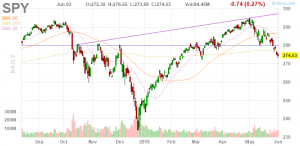One of the most time-honored trading axioms is that the market hates uncertainty. Two recent developments add to uncertainty and loosen a couple more blocks from the market’s foundation.
This last Friday, it was announced that unless Mexico halted the flow of illegal immigrants into the United States, a series of scaled tariffs, starting at 5% on June 10th would be levied on Mexico’s exports to the United States. Certainly, there are good reasons to secure our border, but what concerns me is that our action against Mexico is punitive toward an issue not related to trade and so represents a broadening in criteria for imposing trade sanctions. When one does an action, it becomes easier to repeat an action. The market hates tariffs, so anything that raises the chance of additional tariffs is a negative.
While our trade balance with China is about 4-1 in favor of China, the United States exports more to Mexico than they do to us, so the market has concerns about the relative benefit to our economy if Mexico retaliates with tariffs of their own. There is also concern that since there have been no benchmarks suggested to score Mexico’s progress to a solution, success or failure will be at the sole judgment of our president. While consistent with Trump’s management style, it makes timing a resolution impossible and adds uncertainty.
Monday morning brought news that the justice dept is readying an anti-trust case against Google. Later reports suggested that Amazon, Facebook, and Apple were also in the crosshairs. As these are four of the world’s top five companies with a combined market cap of around three trillion dollars, the market took the news as one might expect and shares of the aforementioned companies plunged. Because of the huge market weighting of these companies, and despite the fact that more stocks were up than down today, the market averages closed lower as well. Longer term, an anti-trust case would typically take several years to complete and place a cloud over the shares until the case(s) are finally resolved.
All this against a backdrop of a market still teetering from the China tariffs, and sitting on critical technical support levels. On May 14th I wrote:
Near-term, expect headline-driven markets trading in a range defined by the near-term high, SPY 294, and the low on March 8th, about SPY 273. The longer the trade dispute lingers, and the stronger the rhetoric, the lower the potential range. A fall to 273 would represent a pullback of about 7% from the highs. That would be enough to get one’s attention, but not enough to change allocation. A couple of closes below that level would cause me to reassess the potential downside. If the tariffs continue through the summer, the negative news alone would likely land us another 10% (plus) correction. We’ll cross that bridge when we come to it.

We’re not there yet but I can see the bridge around the bend. The market is “oversold” (nothing says it couldn’t become more oversold) and we’re at a level where the market should typically bounce. The saving grace of the market today was the positive breadth, and the fact that the overall market is finding support at this level gives some reason for hope. Also, the VIX, the CBOE volatility index, while elevated, is not showing signs of undue stress. If we don’t get the bounce however, and we get a close tomorrow below SPY 273, I’d put the odds of a 10% or worse correction (we’re already down 7%) at about 80%. Stay tuned. Your questions are always welcome.